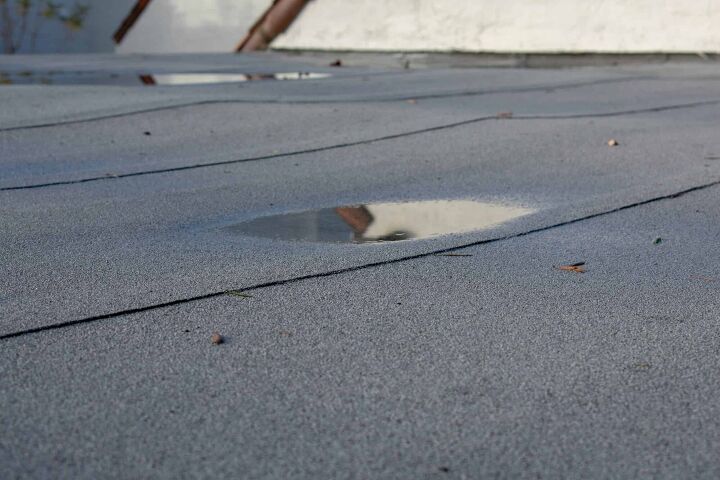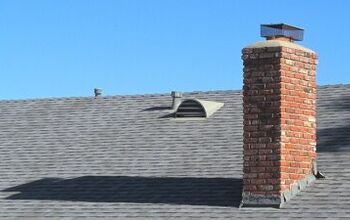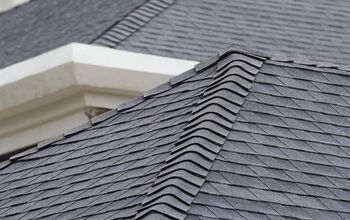Flat Roof Leaks In Heavy Rain? (Possible Causes & Fixes)

Flat roofs are a popular roofing choice used in many homes. They offer a classic look and are easier to build and maintain than many other roofing options.
However, flat roofs aren’t perfect. One of their main issues is that their flat shape lacks the slope needed to naturally control rainwater. This can cause leaks when heavy rains occur.
Flat roof leaks in heavy rain are generally caused by poor construction, degraded shingles, plumbing, or skylights. The only way to identify where the leak is coming from if to go on to the roof itself. To fix the leakage, begin by adding gutters and downspouts, or cleaning them if they are already installed.
Do You Need Roofing Repair Services?
Get free, zero-commitment quotes from pro contractors near you.

Why Do Flat Roofs Leak?
Although flat roofs are common, they’re also more likely to leak than almost every other kind of roof. The reason for this is simple. Flat roofs are incapable of shedding water as efficiently as other roofs.
That being said, flat roofs are generally built with this issue in mind. They’re supposed to be sloped at least a few degrees to ensure that puddles don’t sit on the roof.
The reason why flat roofs leak often comes down to poor construction. When a roofer makes even a small mistake, it can seriously interfere with your roof’s ability to shed excess water. The margin for error is much smaller with flat roofs than it is on other kinds of roofs.
Still, if your flat roof is leaking it isn’t necessarily because of poor construction or some inherent issue with flat roofs. These roofs are susceptible to the same issues that affect other kinds of roofs. Your leak could also be tied to one of these issues.
Why Roofs Leak in Heavy Rain
Your leak could be entirely unrelated to the fact that your roof is flat. For that reason, it’s a good idea to familiarize yourself with the following reasons why any roof could leak during heavy rain.
Skylights
First, your flat roof could be leaking during the heavy rain because of a problem with a skylight. Common causes of this are damage, improperly installed flashing, and gaps around the framing of the skylight.
If your leak is mostly near a skylight, then make sure to check that before getting started on any intensive roof repairs.
Plumbing
Plumbing can also be an issue during heavy rain. For example, your home may have a ventilation fan duct that allows a leak to occur. These issues may only come up when enough rain falls to make them obvious.
Degraded Shingles
Roofing shingles last for a long time. However, they don’t last forever. Eventually, yours will start to dry out. When this happens, they won’t be able to keep water out of your home any longer. If your roof leaks only during heavy rain, then it could be a sign that you need to replace old roofing materials.
Metal Corrosion
It’s also possible that cracks in metal and corrosion around fasteners are causing your roof to leak. Expansion and contraction can even loosen the seams in a metal roof over time. Be sure to check these issues before committing to expensive roof repairs.
Natural Damage
Heavy rain often comes with heavy wind. It’s possible that a tree or branch has fallen on your roof and caused some damage. This can also cause leaks, which may only become apparent during heavy rain.
Fixing a Flat Roof that Leaks Only During Heavy Rain
The first step in fixing a leaking flat roof is to identify the source of the leak. Use the information provided in the previous sections to narrow down your problem. Start with issues that have easier fixes and then work towards the more serious issues until you identify the problem.
Ultimately, it’s likely that you’ll want to increase your roof’s ability to shed excess water. This is best done by installing gutters and downspouts. The next section will guide you through that process.
How to Add Gutters and Downspouts to a Flat Roof
Adding gutters and downspouts to your roof could be just what you need to prevent future leaks from occurring. Here’s a step-by-step guide on how to do it.
- Measure the roof and use that information to figure out where you’re going to place your downspouts.
- Cut the gutters with a saw. Use the measurements obtained in step one to ensure that you make them the right length.
- Place the gutters on the ground next to each other. They should have an overlap of about 2 inches.
- Drill six evenly spaced holes at each overlap. The holes should be 1/8-inch large and just a fraction away from the edge. Next, put rivets into the holes and secure each of them with a rivet gun.
- Use a caulk gun to seal the underside of each gutter.
- Cut the downspout lines with tin snips. Once you do, line them with a gutter sealant.
- Begin attaching the gutters to your home. Use hook hangers and screw them into fascia boards spaced about 18 inches apart.
- Install the downspouts into the outlets and attach those to the side of your home. Once finished, seal them with a gutter sealant for extra waterproofing. You can also add aluminum mounting straps for extra security.
Can a Leaking Roof Collapse?
If your flat roof is leaking, then you may have already begun worrying about how that might be affecting the integrity of your roof. You should know that untreated leaks can eventually cause a roof to collapse.
Roofs may collapse when their components become saturated with rainwater. Water weakens your roof. Over time, this can cause the components to break entirely and fall into your home.
For these reasons, it’s a good idea to familiarize yourself with the signs of an impending roof collapse. Doing so could help you address your roofing issues before they bring the whole thing down.
First, keep an eye out for structural problems. Bends, ripples, and other evidence of roof stress are signs that a collapse could be coming soon. Call a professional out to investigate before these problems bring your roof down.
You should also pay attention to masonry issues. Cracks in your masonry can be a major sign that your roof is going to collapse soon. Other signs of an impending collapse include:
- Interior cracks or gaps
- Shifting sprinklers
- Unexplained noises
The Advantages of Flat Roofs
Flat roofs aren’t all bad. If you’re considering utilizing one, it’s worth taking the time to examine the advantages of doing so. One of the best examples of this is cost. Both the material and labor costs of installing a flat roof are much lower than they are for other types of roofs.
Flat roofs also give homeowners more usable space. They can easily be turned into an incredible outdoor lounge space. You can even set up a garden on top of them. This simply isn’t possible with other kinds of roofs.
Flat roofs are also much easier to install and maintain. It’s very easy to work on top of a flat roof. They also have fewer complications than other kinds of roofs. This means you’ll spend less on repairs and damages throughout the lifespan of your flat roof.
Although flat roofs are more prone to leaks, they’re still absolutely worth installing in a new home. If you value price, usable space, and ease of repairs, then a flat roof could be your best roofing option.
Do You Need Roofing Repair Services?
Get free, zero-commitment quotes from pro contractors near you.

Related Questions
How do you find a leak in a flat roof?
The only way to find the source of your leak is to get on top of your roof. Once there, keep an eye out for any signs of a leak. You may find a low spot in your roof that’s surrounded by a dirt-stained ring or other evidence of pooling water. Make sure that you wait for a dry day before venturing on top of your roof to keep yourself safe.
Will a flat roof always leak?
No, flat roofs aren’t always going to leak. When built properly, they should be constructed at enough of a slope to prevent water from pooling on top of them. Leaks are more common on flat roofs but you shouldn’t assume that you’re going to have one just because you’ve installed a flat roof.

Kellan is a content writer who specializes in everything DIY. When he's not behind the keyboard, he enjoys spending time with his pets, playing music, and geeking out about basketball. He hopes to make your home improvement projects a little bit easier to accomplish.
More by Kellan Jansen



























